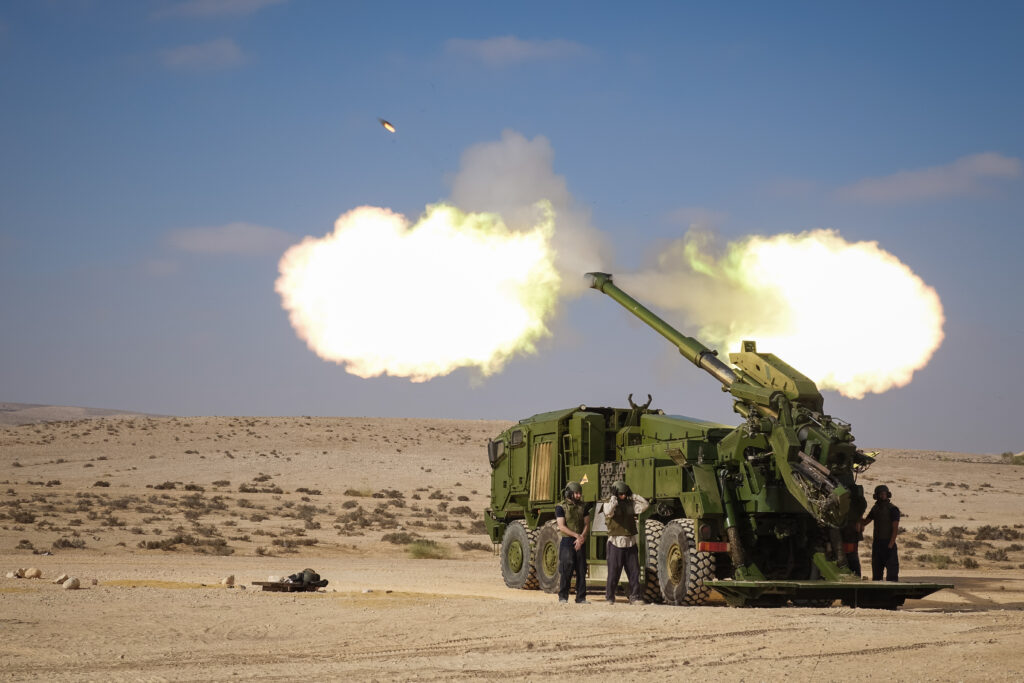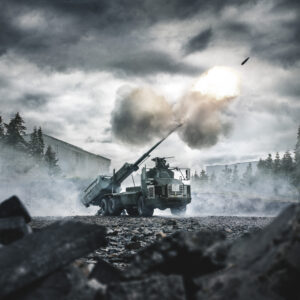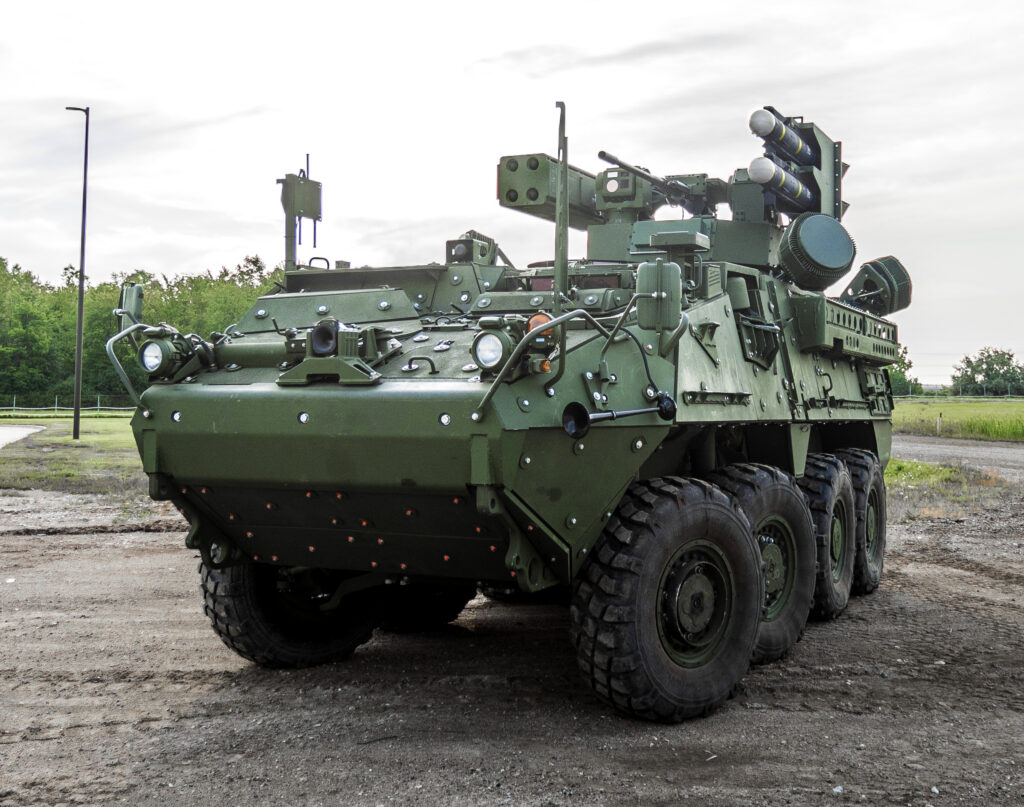
The 8×8 “Iron Sabre” variant of the Elbit ATMOS howitzer.
WASHINGTON: US Army soldiers will get to fire their Israeli counterparts’ newest howitzer early next year, when the Elbit ATMOS participates in a shoot off alongside rival guns. The weapon is already in service with the Israeli Defense Force and other nations; this will be its American debut.
All the competitors are 155mm howitzers mounted on trucks – typically six or eight-wheeled – and it’s an increasingly crowded field. While the Army isn’t announcing which companies have won contracts to come to the shoot off, there are reports of at least three other Army-approved competitors:
- AM General, maker of the iconic Humvee, is offering the Brutus, boasting a unique recoil-reduction system (built by Mandus Group) that lets them mount the gun on a relatively lightweight truck. (They already put a lighter 105mm gun on a Humvee). This is a brand-new system not in service with any army.

BAE illustration of their Archer self-propelled howitzer
- BAE Systems, which builds the M2 Bradley and other heavy armored vehicles, is offering the Archer, built by its Swedish branch and already in service with the Swedish army.
- Global Military Products is offering a Serbian gun, the Yugoimport NORA. We frankly don’t know much about this one.
- And now there’s the Israeli ATMOS. Elbit, an up-and-coming company in Israel, is specifically bringing the same 8×8 configuration used by the Israeli Defense Force, nicknamed “Iron Sabre.” (There’s a strange fad of Israeli of naming weapons systems “Iron [Whatever]”; a saber made of ordinary iron, as opposed to quality steel, would be brittle and dull).
Why so many foreign systems? Well, a wheeled self-propelled howitzer is something a lot of other armies use, but the US military hasn’t wanted until now. Many other nations – Russia, France, and Israel itself come to mind – rely heavily on wheeled armored fighting vehicles, which are generally much cheaper to buy and maintain than tracked ones.
The US Army’s heavy armored units, however, have long disdained wheeled armor and equipped themselves exclusively with tracked ones, even in supporting roles, because tracked machines can carry much more weight – especially armor – and move better over rough terrain. The Army is currently both modernizing its M109 Paladin howitzers and testing a next-generation Extended Range Cannon Artillery (ERCA) system, both heavy tracked machines built by BAE.
Meanwhile, the US Army’s light infantry units are optimized for rapid deployment by plane and helicopter, so they keep the use of any vehicles to a minimum. Their main howitzer is the M777 (also built by BAE), which is a modernized, ultra-light version of the traditional towed artillery piece.
So most of the American army is either too heavy or too light for truck-mounted artillery. But since 2003, there’ve been a few medium weight brigades in between, built around the 8×8 Stryker armored vehicle. There are many Stryker variants, from troop carriers to mobile command posts, with new upgunned, anti-aircraft, and electronic warfare variants in the offing.

Stryker anti-aircraft variant, IM-SHORAD (Interim Maneuver Short-Range Air Defense), armed with guns and missiles. A laser-armed variant will enter service in 2022.
But the heaviest weapon a Stryker ever mounted was a 105mm tank gun, and that Mobile Gun System model proved badly overloaded. So for artillery support, Stryker units have relied on the same towed howitzers as light infantry. That’s worked okay against guerrillas in Afghanistan and Iraq. But in a conventional war against Russia or China, perhaps even Iran or North Korea, a towed gun can’t move fast enough: By the time it’s unloaded, fired some rounds, and gotten loaded back up again, the enemy will have backtracked the trajectory of those shells and launched a retaliatory barrage.
By contrast, ATMOS can “shoot and scoot” in just two minutes: 30 seconds to stop and set up, 60 seconds to fire “six or seven” rounds, and 30 seconds to get moving again. It also boasts a top road speed of 50 mph. “It’s designed for speed, both in transit and in emplacement,” Elbit America exec Dave Richards told reporters this afternoon. “It’s able to go from moving to first rounds out in less than thirty seconds with a four-man crew.”
(For comparison, BAE boasts that Archer can stop and start shooting in 20 seconds).
The Elbit vehicle’s crew size could go down in future upgrades, Richards said. While the current ATMOS model uses a “semi-automatic” loading system that provides significant assistance to the human crew, he said, Elbit’s developed a fully automatic loader that is “almost ready for delivery to the IDF.” (Archer already has an autoloader, allowing a three-man crew).
The company’s also talking with the US Army about potentially building an autoloader for the new ERCA tracked howitzer, he said. By contrast, the current Paladin and M777 are both loaded entirely by hand, an exhausting process that’s hard to keep up without slowing down or getting injured or both. If the Israeli Defense Force is happy with the autoloader, that’ll encourage the US to buy it too.
In fact, IDF endorsement is a big deal for the US Army, which is buying a bunch of other Israeli systems to fill glaring gaps in its arsenal. That includes Active Protection Systems for armored vehicles – basically miniature missile defenses to shoot down incoming anti-tank missiles – such as the Rafael Trophy and the IMI Iron Fist, as well as the anti-rocket and missile defense system called Iron Dome. (That said, Congress ordered a reluctant Army to buy Iron Dome as a stopgap because its in-house program was taking too long). The US also has a long and highly classified history of collaboration with Israel in intelligence and cyber warfare.
Elbit argues their Israeli army experience proves their reliability. They haven’t gone to a full autoloader yet like Archer, nor to an ultra-low-recoil system like Brutus, but that’s because they wanted to stick with proven technologies that were easier to maintain and cheaper to build.
Elbit’s final selling point is customization. They’re building the Iron Sabre version on an 8×8 truck with Israeli fire-control systems for the IDF, but they’ve made other models for other customers, installing the same gun on different trucks – including a 6×6 – with different fire controls. They can make lighter models that carry fewer rounds onboard, Richards said, or heavy-duty versions that carry largo ammo loads.
Any version for the US Army could be mounted on an American-made truck, connected to the American AFATDS network, and potentially made in the USA, Richards said: “We do have a multi-year plan where we are looking to facilitate ATMOS production capability in the United States.”
As Breaking Defense readers know, Israeli armsmakers are increasingly coming to America to set up subsidiaries, alliances, and production plants, driven in part by new Foreign Military Financing rules that require American military aid to be largely spent in US dollars on US products.
But before Elbit starts building ATMOS in America, it needs to win an American contract. The Army has not set out an acquisition strategy or a timeline to move from the shoot-off demonstration to a competitive procurement. But good performance in shoot-off will help a lot. That’s specially true because it will be actual US artillery soldiers firing the guns, not contractors, given Army troops hands-on experience — part of the Army’s push to get first-hand feedback from soldiers before buying new technology.
“There’s gonna be multiple phases over the several months of firing tests,” Richards said. Details are still being thrashed out, he said, “but it’s going to be hundreds of rounds, for sure.”
Head start: Early ’25 may be first flight for Black Hawk with T901 engine
Sikorsky is using remaining FARA dollars to test out the new T901 engine in anticipation of integrating it on a UH-60 M Black Hawk later this year.


























